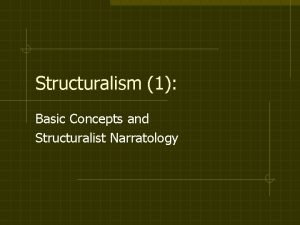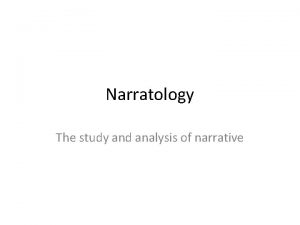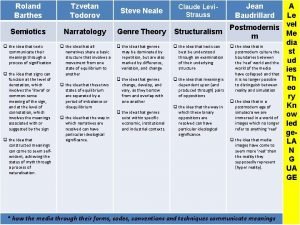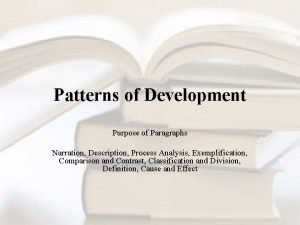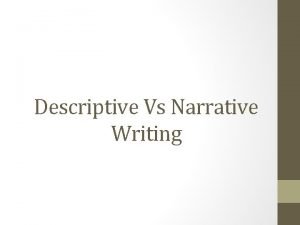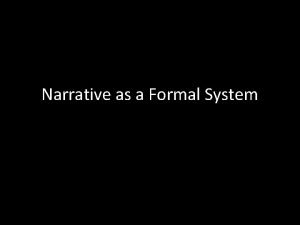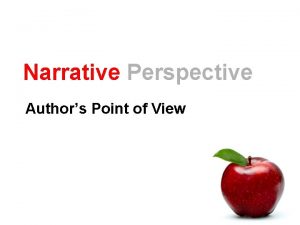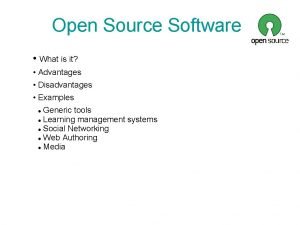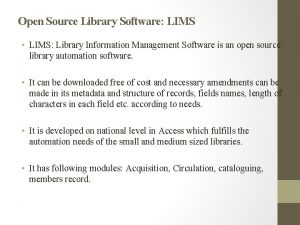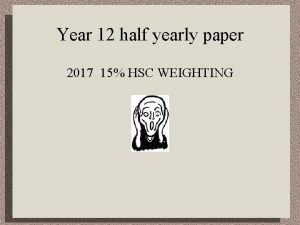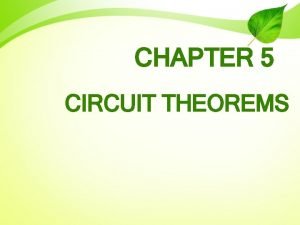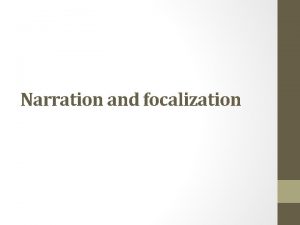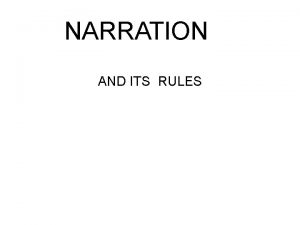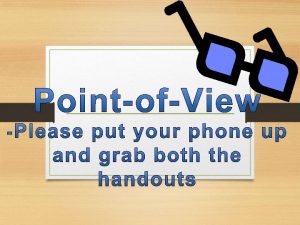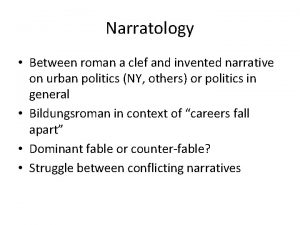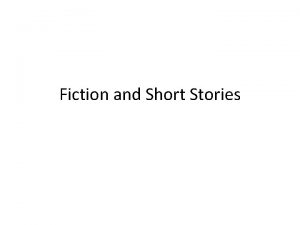Narration and focalization Source Jahn Narratology Narration Narration































- Slides: 31

Narration and focalization

Source: Jahn, Narratology

Narration • Narration is the telling of the story • The narrator tells the story – However, in electronic media the concept of narration is more problematic than in literature – There may be no single narrator • Filmic Composition Device • Some say there is no narrator at all • Others say that the ‘auteur’ is the narrator (usually the director)

Narration in film

Narration • Narration can come from ‘within’ the fictional world (“homodiegetic”) or ‘outside’ the fictional world (“heterodiegetic”) • Narration can be very obvious (“overt”) or may be hard to detect (“covert”) • The narrator may take the viewpoint of a character, may present the views of several characters or may approach the story from a godlike view (“omniscience”)

Homodiegetic narrative • The homodiegetic narrative is delivered by a story character—someone actively involved in the narrative. Usually, he then uses the firstperson pronoun in his address (but not always). He may be the protagonist or just a bit player, but he is somehow affecting or affected by the actions going on in the story. – First-person shooters take this visual perspective

Homodiegetic narrator • The author/auteur must decide which character will narrate. • The perspective of the narrator strongly influences what the audience member will see, hear and know about the plot, other characters, etc. – If a minor character is chosen, the information available to the audience may be quite limited.

Displacement of time • Homodiegetic narrators often tell a story about things that they experienced some time in the past – A common form of such narration gives an account of the narrator’s earlier life • The Wonder Years • Stand By Me • Titanic

Limitations of homodiegetic narration • “she is subject to 'ordinary human limitations'. . . she is restricted to a personal and subjective point of view; she has no direct access to (or authority on) events she did not witness in person; she can't be in two places at the same time. . . and she has no way of knowing for certain what went on in the minds of other characters”. • Jahn, Narratology

Unreliable narrators • Narrators you cannot trust to provide a full and accurate account are called ‘unreliable narrators’ • A common feature of first-person narration is that you can’t trust the narrator – Dishonest – Unstable – Forgetful – Mistaken – Biased

Heterodiegetic narration • Heterodiegetic narration comes from a narrator who is not a character in the story. • Heterodiegetic narrators vary widely in their knowledge and perspective. They may be restricted to the perspective of a single ‘person’ or may have ‘omniscience’— boundless ability to know all there is to know about the plot, characters, setting, etc. in a story.

Heterodiegetic narrative • “a homodiegetic narrator always tells a story of personal experience, whereas a heterodiegetic narrator tells a story about other people's experiences. ” (Jahn)

Overtness • How obvious (or overt) is the narration? An overt narrator is out in the open—a focus of the audience member’s attention. A hidden narrator is covert. • An overt narrator makes the telling or construction of the story an important focus for the audience

Textual elements that project narrative voice (Jahn): • “Content matter -- there are naturally and culturally appropriate voices for sad and happy, comic and tragic subjects (though precise type of intonation never follows automatically). • Subjective expressions -- expressions (or 'expressivity markers') that indicate the narrator's education, his/her beliefs, convictions, interests, values, political and ideological orientation, attitude towards people, events, and things. ”

• “Pragmatic signals -- expressions that signal the narrator's awareness of an audience and the degree of his/her orientation towards it. ”

Indicators of film narration • In film, television, videogames, etc. five main indicators of narration are present: • Voice over (VO) narration—an off-camera voice speaks to the audience member • Much more rarely, an onscreen narrator is present • The point of view of the camera • Intrusive visual effects • Onscreen writing • Much of the craft of traditional Hollywood style is in making the narration covert.

• Hitchcock makes it very clear to us. There's an objective and a subjective camera, like there's a third- and a first-person narrator in literature. Manuel Puig

How does the narrator address the audience? • The narrator can take the first-person or thirdperson position vis-à-vis the implied audience member. – Second-person is particularly difficult, but could theoretically be taken • An offscreen voice telling an amnesiac what he did as the camera demonstrates it

Paralepsis (Jahn) • An infraction caused by saying too much; a narrator assuming a competence she does not properly have; typically, a first-person narrator (or a historiographer) narrating what somebody else thought. . . or what happened when she was not present.

Paralipsis (Jahn) • An infraction caused by omitting crucial information; saying too little; typically, an authorial narrator pretending "not to know" what happened in her/his characters' minds, or what went on at the same time in another place, or distortively censoring a character's thought, or generally pretending to be restricted to ordinary human limitations.

• “Paralepsis and paralipsis are instances of violations of Grice's (1975) famous principle of co-operation -- the notion that speakers (narrators) are socially obliged to follow an established set of 'maxims': to give the right amount of information, to speak the truth, to speak to a purpose (tell something worth telling), to be relevant, etc. ”

Focalization • Focalization refers to the viewpoint from which the story is told – Usually the viewpoint of the narrator • omniscient • However, the viewpoint can be split from the narration – The narrator (or FCD) can focus on the story based on a character’s perspective

The omniscient narrator • The most common view taken in Western narratives (fiction or non-fiction) is a covert omniscient view. That is, the persons telling the tales are not obvious, are not characters in the story, and adopt an ‘omniscient’ or ‘godlike’ point of view • Audience members are privy to information about the plot (what events have occurred and what their relationships are), the characters (and what they are thinking), the setting, and the backstory. – The reader/audience member has information unavailable to any of the characters.

Advantages of omniscience • The viewer/reader can know things that are unknown to the characters • The position allows for evaluation of characters and their actions • The story can be more ‘expansive’—it can include a much wider set of characters, motives, actions • In some cases, the distance between the audience member and the characters is a good thing

Internal focalization • “The technique of presenting something from the point of view of a story-internal character is called internal focalization. The character through whose eyes the action is presented is called an internal focalizer” • Jahn, Narratology

Internal Focalization • Though not actually a character in the story, the narrator takes on the perspective of a story character and relates the story from that person’s perspective. • The narrator ‘gets inside the head’ of that character, often relating their fears, beliefs, etc. to the implied audience member.

Internal focalization • “One of the main effects of internal focalization is to attract attention to the mind of the reflector-character and away from the narrator and the process of narratorial mediation. ” (Jahn)

Representing focalization • Focalization can be represented by over-theshoulder camera shots, shot-reverse shot representations of interactions among characters, focus on a character looking into the distance then turning to adopt the sightline of the looker, etc. • Internal thoughts represented by VO

Camerawork (Jahn) • “gaze shot • A picture of a character looking ('gazing') at something not currently shown. A gaze shot is usually followed by a POV shot (or sometimes it is preceded by a POV shot)”. • point of view shot, POV shot • “The camera assumes the position of a character and shows the object of his or her gaze. “

• “over-the-shoulder shot • The camera gets close to, but not fully into, the viewing position of a character. . . • reaction shot • A shot showing a character reacting (with wonder, amusement, annoyance, horror, etc. ) to what s/he has just seen. ”

Shifting narration and focalization • Narration can shift within a given text— perhaps between omniscient and first-person or from one character to another. • Focalization shifts very commonly in electronic media texts • Shifting narrative position is very common in electronic media.
 Johann bernhard basedow contribution in physical education
Johann bernhard basedow contribution in physical education Petr jahn
Petr jahn Oa monitor
Oa monitor Basic concepts of structuralism
Basic concepts of structuralism Freitag's pyramid
Freitag's pyramid Narratology vs ludology
Narratology vs ludology Todorov narratology
Todorov narratology Art that breaks the rules, artifice over nature
Art that breaks the rules, artifice over nature Narration and dialogue
Narration and dialogue Development by narration example
Development by narration example Classification pattern of development
Classification pattern of development Conclusion styles
Conclusion styles Formal narrative
Formal narrative Narration and dialogue
Narration and dialogue Reported speech exercises
Reported speech exercises Translocation of sugars in plants
Translocation of sugars in plants Source and sink model
Source and sink model Praise the source of faith and learning
Praise the source of faith and learning Books of prime entries
Books of prime entries Open source disadvantages
Open source disadvantages Open source library software
Open source library software What are source cards?
What are source cards? Module 4 - open source software and licensing
Module 4 - open source software and licensing Conceptual meaning in semantics
Conceptual meaning in semantics Open source command and control software
Open source command and control software Pompeii and herculaneum source booklet
Pompeii and herculaneum source booklet What is source text
What is source text Persuasive matrix
Persuasive matrix Source message and channel factors
Source message and channel factors Primary and secondary sources of light
Primary and secondary sources of light Benefits of free software
Benefits of free software Norton equation
Norton equation



